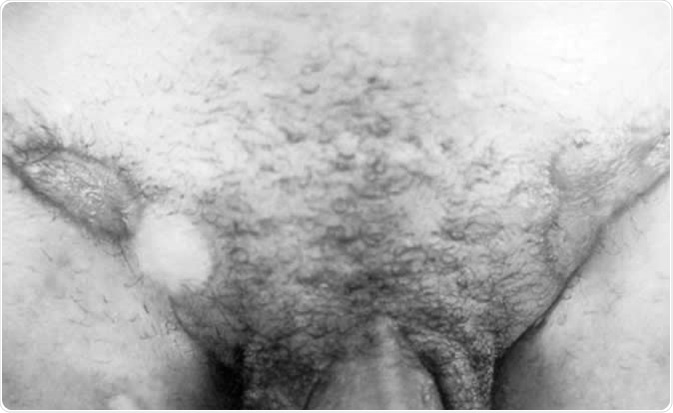Granuloma inguinale (also known as donovanosis) is one of the genital ulcerative sexually-transmitted diseases characterized by pronounced granulomatous ulceration of the genitalia and perigenital sites. Although the disease is considered only mildly contagious, its course is indolent, progressive and chronic.
The diagnosis is most often made on clinical grounds (as the granulomatous process is highly characteristics), but sometimes it is confirmed by microscopic finding of Donovan bodies on tissue smears. In recent years molecular methods are becoming commonly used to confirm the disease. A prolonged course of antibiotic therapy (namely azithromycin) is warranted when treating this condition, usually until the sores heal completely.

A photograph of granuloma inguinale identified through differential diagnostic technique. The differential diagnosis proved to be that of granuloma inguinale and not Syphilis. Granuloma inguinale, caused by Calymmatobacterium granulomatis, results in surface destruction and granuloma formation of the skin and subcutaneous tissue. Image Credit: CDC/Susan Lindsley
History and Etiology
The first precise clinical description of the disease was offered by McLeod in Calcutta (India) in 1882, when he named this condition as serpiginous ulceration of the groin. The causal agent was described later by Donovan in 1905, who described the characteristic Donovan bodies while working in Madras.
However, culturing this organism proved to be cumbersome. Two Brazilian scientists – Aragão and Vianna – claimed to culture the organism in 1913, and even used emetic tartar to treat the condition afterwards. They were also the first researchers to classify the causative agent. Still, further culturing attempts were largely unsuccessful until 1943.
Later research has revealed their morphologic features as Gram-negative coccobacilli with more intense whitening in the extremities. The bacteria were also characterized as immotile, intracytoplasmic and between 0.02 to 0.2 micrometers in size in their initial phase. Electron microscopy analyses revealed a large capsule, a cell wall with filiform protrusions, and the lack of flagella.
In 1951, when Rajam and Rangiah were working in Madras, a comprehensive monograph was published that described the experience of examining and treating approximately 2000 of donovanosis cases over a period of twenty years. From the mid-1960s until the early 1990s the reports on the condition were quite limited, but interest was renewed when donovanosis was linked with HIV infection.
Nomenclature Controversies
Debate on what is the most suitable nomenclature for the causative agent is still ongoing. Original work from Aragão and Vianna resulted in naming this pleomorphic bacterium Calymmatobacterium granulomatis; nevertheless, a myriad of research studies proposed a link to the genus Klebsiella.
Following the advent of molecular technology (and specifically polymerase chain reaction or PCR), DNA sequencing of specific genes has shown that C. granulomatis actually shows more than 99 percent similarity with Klebsiella pneumoniae and Klebsiella rhinoscleromatis. Therefore, a proposal immediately emerged to reclassify this particular microorganism as Klebsiella granulomatis comb. nov.
Not long after that, other scientists completed a phylogenetic analysis of this pathogen (based on 16S ribosomal RNA genetic sequences) which demonstrated that the tested strains had only 95 and 94 percent of similarity to the genus Klebsiella and genus Enterobacter, respectively. The conclusion was that Calymmatobacterium granulomatis was in fact a unique species from the subclass of Proteobacteria.
In any case, differences in the obtained results have not been fully explained; hence we must still resolve the classification of the causative agent. Regardless of that, donovanosis should be suspected in the assessment of ulcerative lesions on the genitalia, especially in certain epidemiologic instances.
Sources
- http://www.antimicrobe.org/b108.asp
- https://www.ncbi.nlm.nih.gov/pubmed/26882914
- https://www.ncbi.nlm.nih.gov/pubmed/11394976
- https://medlineplus.gov/ency/article/000636.htm
- https://www.ncbi.nlm.nih.gov/pmc/articles/PMC1758360/
- www.scielo.br/scielo.php
- Lupi O, Chicralla P, Martins CJ. Donovanosis. In: Gross G, Tyring SK, editors. Sexually Transmitted Infections and Sexually Transmitted Diseases. Springer Science & Business Media, 2011; pp. 191-196.
- O’Farrell N. Donovanosis. In: Kumar B, Gupta S, editors. Sexually Transmitted Infections, Second Edition. Elsevier Health Sciences, 2014; pp. 533-541.
Further Reading
Last Updated: Feb 26, 2019